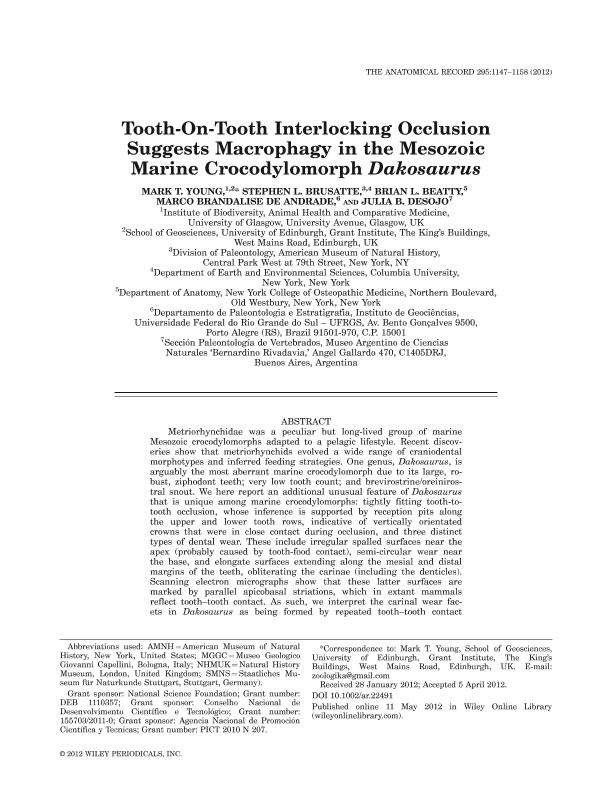Artículo
Tooth-On-Tooth Interlocking Occlusion Suggests Macrophagy in the Mesozoic Marine Crocodylomorph Dakosaurus
Young, Mark T.; Brusatte, Stephen L.; Beatty, Brian L.; Brandalise de Andrade, Marco; Desojo, Julia Brenda

Fecha de publicación:
07/2012
Editorial:
Wiley-liss, Div John Wiley & Sons Inc
Revista:
Anatomical Record-Advances in Integrative Anatomy and Evolutionary Biology
ISSN:
1932-8486
Idioma:
Inglés
Tipo de recurso:
Artículo publicado
Resumen
Metriorhynchidae was a peculiar but long-lived group of marine Mesozoic crocodylomorphs adapted to a pelagic lifestyle. Recent discoveries show that metriorhynchids evolved a wide range of craniodental morphotypes and inferred feeding strategies. One genus, Dakosaurus, is arguably the most aberrant marine crocodylomorph due to its large, robust, ziphodont teeth; very low tooth count; and brevirostrine/oreinirostral snout. We here report an additional unusual feature of Dakosaurus that is unique among marine crocodylomorphs: tightly fitting tooth-to-tooth occlusion, whose inference is supported by reception pits along the upper and lower tooth rows, indicative of vertically orientated crowns that were in close contact during occlusion, and three distinct types of dental wear. These include irregular spalled surfaces near the apex (probably caused by tooth-food contact), semi-circular wear near the base, and elongate surfaces extending along the mesial and distal margins of the teeth, obliterating the carinae (including the denticles). Scanning electron micrographs show that these latter surfaces are marked by parallel apicobasal striations, which in extant mammals reflect tooth-tooth contact. As such, we interpret the carinal wear facets in Dakosaurus as being formed by repeated tooth-tooth contact between the mesial and distal margins of the teeth of the upper and lower jaw. We posit that this increased the available shearing surface on their high crowns. Together, these wear patterns suggest that occlusion in Dakosaurus was specialized for cutting large and abrasive prey items into portions small enough to swallow, making it a prime example of an aquatic reptile with macrophagous feeding habits. © 2012 Wiley-Periodicals, Inc.
Palabras clave:
Feeding
,
Functional Ecology
,
Metriorhynchidae
,
Occlusion
,
Thalattosuchia
Archivos asociados
Licencia
Identificadores
Colecciones
Articulos(MACNBR)
Articulos de MUSEO ARG.DE CS.NAT "BERNARDINO RIVADAVIA"
Articulos de MUSEO ARG.DE CS.NAT "BERNARDINO RIVADAVIA"
Citación
Young, Mark T.; Brusatte, Stephen L.; Beatty, Brian L.; Brandalise de Andrade, Marco; Desojo, Julia Brenda; Tooth-On-Tooth Interlocking Occlusion Suggests Macrophagy in the Mesozoic Marine Crocodylomorph Dakosaurus; Wiley-liss, Div John Wiley & Sons Inc; Anatomical Record-Advances in Integrative Anatomy and Evolutionary Biology; 295; 7; 7-2012; 1147-1158
Compartir
Altmétricas



